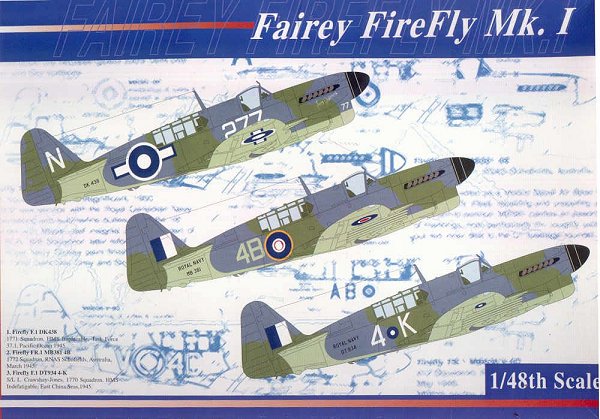
|
KIT: |
Grand Phoenix 1/48 Firefly I |
|
KIT # |
001 |
|
PRICE: |
$45.00 MSRP |
|
DECALS: |
Three aircraft |
|
REVIEWER: |
|
|
NOTES: |
|

|
HISTORY |
The Fleet Air Arm was the only carrier air arm to carry on with the development and operation of the two-seat carrier fighter past the early 1930s. Both the Japanese and American naval air forces determined that the extra weight of the second crewman had too much negative effect on aircraft performance to justify the "safety" of over-water operations with a dedicated navigator-radioman aboard. As was shown during the Second World War, this was the right decision.
The Fleet Air Arm continued with development and operation of the Osprey, a carrier-based version of the land-based Hawker Demon through the 1930s, and followed this up with the Fairey Fulmar, which first flew in January 1940. Using the same engine as the Hurricane and Spitfire, the Fulmar was 50 percent larger and more than 50 percent heavier, with subsequent loss of performance and maneuverability. Unfortunately for the FAA, the war was upon them and the Fulmar was the only aircraft even approaching the performance of modern fighters that was operating on their carriers. With a top speed of only 258 mph, even though it had the same eight-gun armament as its land-based compatriots, the Fulmar was hard-pressed in combat against agile Italian fighters in the Mediterranean, and could only hope to intercept the S.79 Aerosiluranti if it was favorably positioned for a diving attack from sufficient altitude to build up the necessary speed. Nonetheless, until the arrival of the Sea Hurricane in sizeable numbers in 1942, the Fulmar gave a good account of itself over the Mediterranean, as well as on the Arctic convoys where it fought Ju-87 and Ju-88 divebombers and He-111 torpedo bombers.
In July 1939, while the Fulmar was still under construction, the FAA put out another requirement for a modern carrier-based fighter to be powered by the then new and untried Rolls-Royce Griffon. Specification N8/39 calling for a two-seater powered by this engine and armed with 4 20mm cannon or eight .30-cal machine guns. Fairey responded with a somewhat smaller, Fulmar-type aircraft, to be armed with 20mm cannon, with an empty weight barely less than the Fulmar's loaded weight. By June 6, 1940, the mock-up had been inspected and approved, and specification N5/40 was written around the design. Thirteen months later, the first Firefly I, Z1826, flew on December 22, 1941.
The airplane was the first to make use of the Fairey-patented area-increasing Youngman flaps, which provided the necessary maneuverability in combat, and lowered the landing speed of this heavy aircraft to a speed compatible with carrier operation. The first production aircraft was turned over to the FAA on March 4, 1943, a very respectable timetable for wartime aircraft development. The FAA was fortunate with this, because every other British-designed carrier aircraft that was ordered in the same timeframe as the Firefly ran into development difficulties and failed to fly before the end of the war. Thus, the Fulmar would be the only really modern, high-performance carrier aircraft of British design to fly off British carriers in the war it was designed for.
Unfortunately, even with the 1,735 horsepower of the Griffon IIB, the Firefly lacked performance, with a top speed of only 319 mph and a climb rate under 2,000 fpm, though it had a useful range of 774 miles on internal fuel. The Firely was destined to become a strike and tactical reconaissance aircraft, rather than the fleet defense fighter originally called for. Fortunately, it was more than capable of the mission, and the aircraft in its developed versions would form the backbone of the Royal Navy's aerial strike force through the end of the Korean War.
Interestingly, on all points save speed, a Firefly I sent to the US Navy test center at Patuxent River in 1944 more than held its own in air combat against the standard U.S. Navy carrier fighter, the F6F Hellcat - those Youngman flaps worked.
1770 Squadron formed on Fireflies on October 1, 1943, followed by 1771 Squadron in February 1944. 1770 participated in Operation Mascot, the failed attack against the German battleship "Tirpitz" on July 17, 1944, operating from HMS "Indefatigable." 1771 Squadron, aboard HMS "Implacable," flew strikes in Norwegian waters that October, by which time "Indefatigable" and her Fireflies had moved on to join the British Far Eastern Fleet.
From January 1-7, 1945, 1770 Squadron's Fireflies flew rocket strikes against the Pangkalan Brandon refinery on Sumatra, during which Lieutenant D. Levitt shot down a Ki.43 Hayabusa while Sub Lieutenants Redding and Stot shared another in air combat on January 4. 1770 scored two more Ki.43s on January 24, during strikes on the Palembang refineries at Pladjoe and Songei Gerong that required the aircraft to attack through balloon barrages and heavy AAA fire. On January 29, the Fireflies added three more Ki-43s to their score before departing Southeast Asia for service with Task Force 57, the British Pacific Fleet, during the coming invasion of Okinawa.
Five days before D-Day, TF 57 launched strikes on Miyako-jima, southwest of Okinawa, following up during the next 25 days with 13 days of strikes against Japanese forces on Okinawa and Taiwan, with the Fireflies participating in all these actions.
When the BPF retired to Sydney for replenishment in late May, they were joined by HMS "Implacable" and the Fireflies of 1771 Squadron. After strikes against Truk, 1771's Fireflies gained the distinction of being the first British aircraft to fly over Japan on July 10, 1945; on July 24, Fireflies from 1771 and 1772 Squadrons - the latter having relieved 1770 aboard "Indefatigable" - became the first British aircraft over Tokyo. By VJ-Day, another Firefly squadron - 1790 - was operating with the BPF in the night fighter role. A year of successful combat had only begun to show what the airplane was capable of.
|
THE KIT |
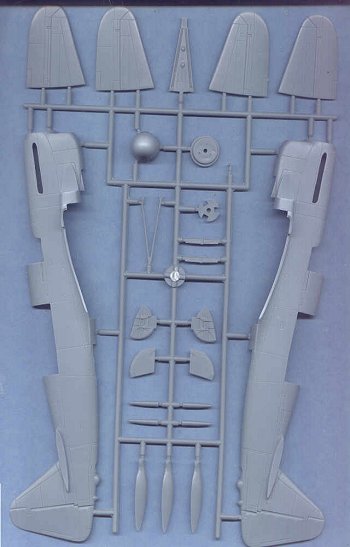 |
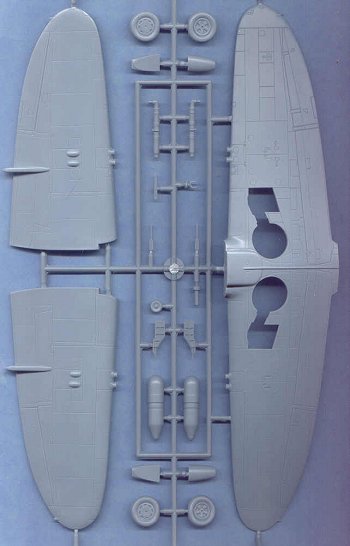 |
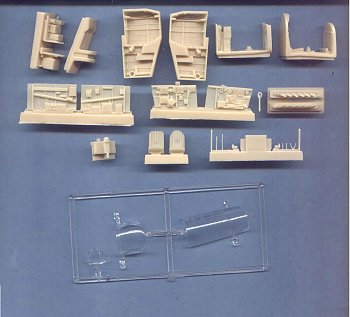 I have always liked the
Firefly. I did the old Frog 1/72 Firefly I a couple times in the 1970s, and
built a PP Aeroproducts vacuform Firefly V in the early 1990s. Thus, I was
really interested when I heard earlier this year that Grand Phoenix, a company
formed by Eagle Strike Productions, was going to bring out a 1/48
injection-molded Firefly F.Mk.I. As I understand it, this first kit will be
shortly followed by the F.R.I, and later by an F.R.IV/V Korean-period Firefly.
I have always liked the
Firefly. I did the old Frog 1/72 Firefly I a couple times in the 1970s, and
built a PP Aeroproducts vacuform Firefly V in the early 1990s. Thus, I was
really interested when I heard earlier this year that Grand Phoenix, a company
formed by Eagle Strike Productions, was going to bring out a 1/48
injection-molded Firefly F.Mk.I. As I understand it, this first kit will be
shortly followed by the F.R.I, and later by an F.R.IV/V Korean-period Firefly.
On opening the box, I was impressed. The Firefly is no small airplane as single-engine fighters go, and it looks suitably massive on the two sprues of medium-grey plastic. On closer inspection, the injection molded parts have very deep panel lines, and will need to be rubbed down with some fine-grit sandpaper, as the surface is a bit "pebbly." As far as the heavy detail is concerned, I think it will look quite acceptable under a couple coats of paint.
The interior parts are done in very crisp resin. I have heard from modelers who are already building theirs that it is absolutely essential that one insure that all the molding blocks on the two cockpits and the wheel wells be sanded off completely if the fuselage and wing sub-assemblies are to fit easily.
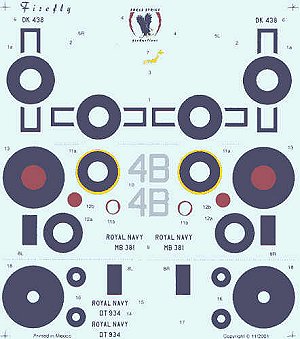 The decals are from Eagle
Strike and provide markings for three aircraft: A Firefly F.I from 1771 Squadron
aboard HMS "Implacable" with the British Pacific Fleet in the summer of 1945; A
Firefly F.R.I from 1772 Squadron in Australia in 1945; and a Fireflyt F.I from
1770 Squadron aboard "Indefatigable" during the Sumatra oil strikes.
The decals are from Eagle
Strike and provide markings for three aircraft: A Firefly F.I from 1771 Squadron
aboard HMS "Implacable" with the British Pacific Fleet in the summer of 1945; A
Firefly F.R.I from 1772 Squadron in Australia in 1945; and a Fireflyt F.I from
1770 Squadron aboard "Indefatigable" during the Sumatra oil strikes.
Unfortunately, the model does not provide any underwing armament, despite the fact the box art shows the 1770 Squadron Firefly carrying rockets on rails. After looking at photos, and going through the spares box, I think the rocket rails from the Tamiya Mosquito F.B.VI will work perfectly, once you cut off the mounting pylons that attach to the wing. You will have to scratchbuild the blast plate, which was in two parts to either inboard and outboard side of the shell ejection chutes for the wing guns.
The cockpit canopies are very clear, and also very thick. I am certain I will be pulling out my trusty Mattel to vacuform the pilot's canopy so it can be posed open, and will do the same for the rear canopy if I find photos of how that canopy opened; at present, every Firefly photo I have access to shows that canopy closed up.
|
CONCLUSIONS |
If you are a Fleet Air Arm fan you likely already have yours and are planning to build it soon. This is going to the top of my to-do pile, and I hope to have a full-build review here at M2 by early May.
Overall, this looks like a very good model of an important airplane, and I am looking forward to it sitting next to the Firefly F.R. Mk.V very soon.
Thanks to Squadron Mail Order for the review copy.
If you would like your product reviewed fairly and quickly by a site that has well over 100,000 visitors a month, please contact me or see other details in the Note to Contributors.